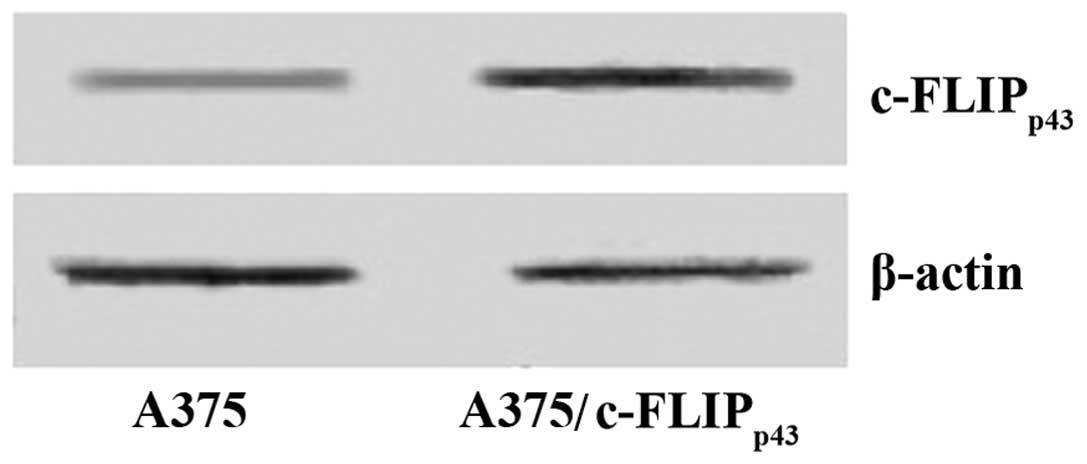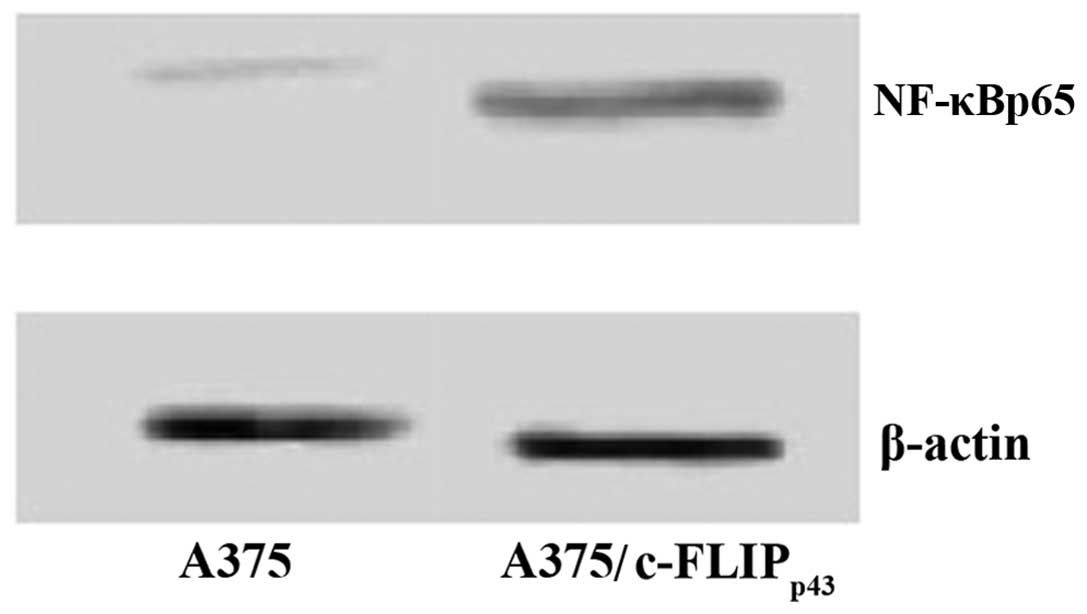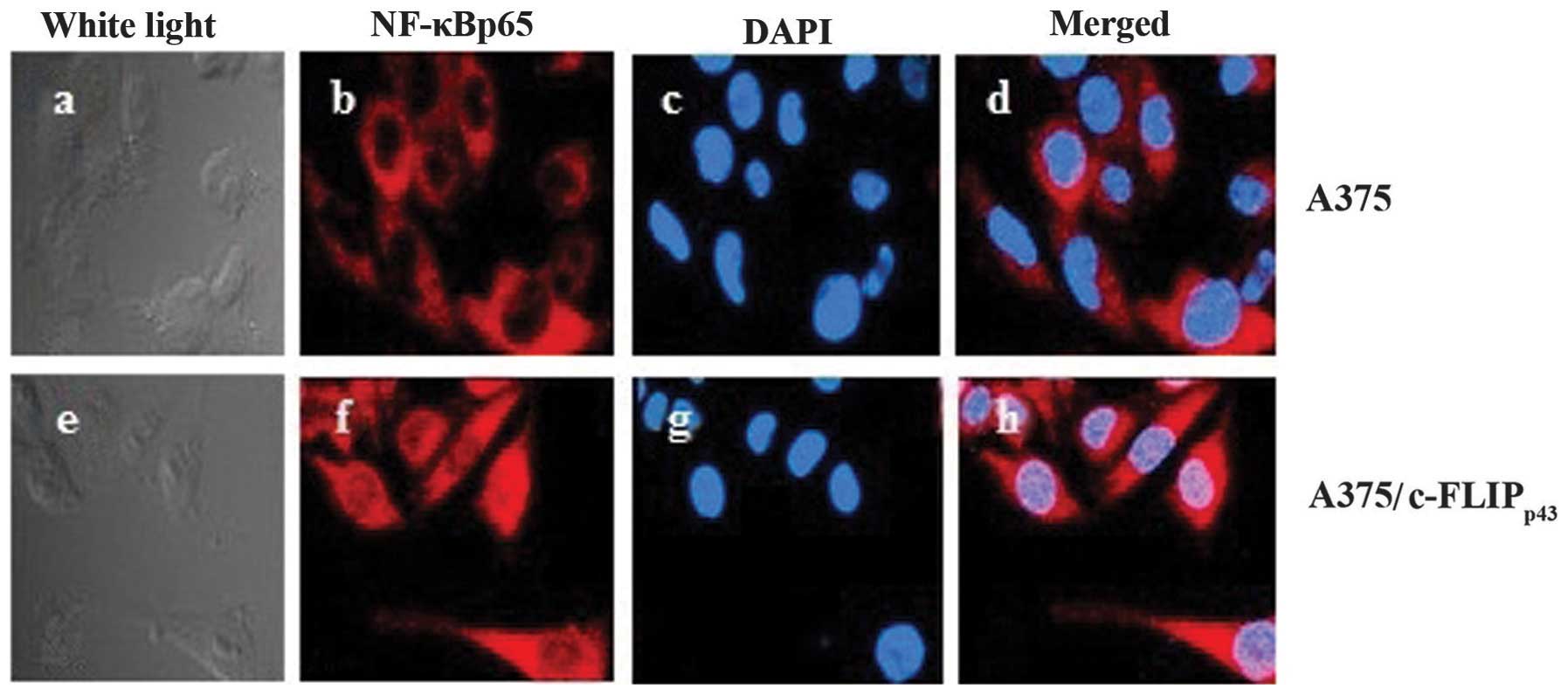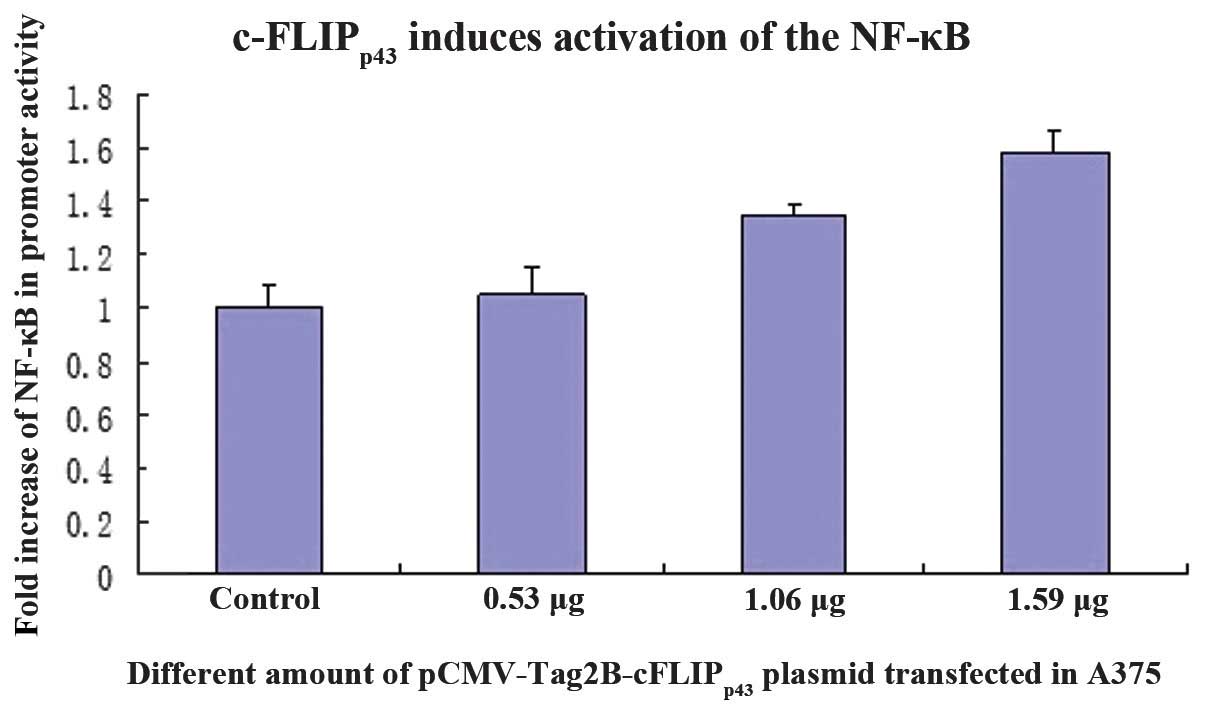c-FLIPp43 induces activation of the nuclear factor‑κB signaling pathway in a dose-dependent manner in the A375 melanoma cell line
- Authors:
- Published online on: July 7, 2014 https://doi.org/10.3892/mmr.2014.2364
- Pages: 1438-1442
Abstract
Introduction
Malignant melanoma (MM) is an aggressive, therapy-resistant malignancy of the melanocytes. The incidence of MM has been steadily increasing worldwide, resulting in an increasing public health problem (1). More than 95% of the MM tumors occur in the skin. MM is ranked as the third most common type of cutaneous malignant tumor, with a high malignance and high potential of hematogenous and lymphatica metastasis. During the progression and therapy of MM, melanoma cell lines demonstrate increased resistance to death receptor-mediated apoptosis and drug-induced apoptosis compared with their normal counterparts (2).
Apoptosis induced by antineoplastic drugs was not affected by the absence of Fas, indicating that cell death was in a Fas-independent manner. The insensitive manner pointed to FLIP-induced apoptosis (3), indicating the existence of another pathway responsible for preventing apoptosis.
Cellular caspase-8 (FLICE)-like inhibitory protein (c-FLIP) was originally identified as an inhibitor of death-receptor signaling through competition with caspase-8 for recruitment to FAS-associated protein with death domain (FADD). c-FLIPL, the long isoform of c-FLIP is specifically processed by caspase 8 into N-terminal c-FLIPp43 and C-terminal c-FLIPp12. In accordance with others studies, we previously identified that compared with the pigmented nevi lesions, the expression of c-FLIP increased and was significantly associated with the histological type and Clark’s level in MM tissue samples (4–6). It was also identified that the downregulated expression of c-FLIP increases apoptosis in MM cell lines. However, the molecular mechanisms of c-FLIP in melanoma pathogenesis remain unclear.
Dohrman and Kataoka et al (7,8) reported that c-FLIPL may be cleaved into c-FLIPp43, promoting the activation of nuclear factor (NF)-κB in CD8+ T cells, human embryonic kidney (HEK) 293 cells and 293 T cells. NF-κB is a pro-inflammatory transcription factor and is activated by various inflammatory agents, carcinogens, tumor promoters and the tumor microenvironment. NF-κB protein, and the proteins regulated by NF-κB are associated with cellular transformation, proliferation, apoptosis suppression, invasion, angiogenesis and metastasis during the genesis of tumors (9). NF-κB is expressed and is constitutively active in the majority of tumor cell lines, including melanoma cells (10). The high level of non-canonical NF-κB activation could be decreased by NIK depletion and thus resulted in increased apoptosis (11).
It remains unclear whether c-FLIPp43 is involved in the pathogenesis of melanoma through NF-κB activation. The aim of the present study was to evaluate whether the regulation of c-FLIPp43 induces the NF-κB signaling pathway in melanoma cell lines and subsequently promotes the progression of melanoma. The present study investigated the expression profile of c-FLIPp43 and NF-κB in melanoma cell lines by immunoblotting. In addition, a eukaryotic expression vector for c-FLIPp43 and a monoclonal A375 cell line with the stable expression of c-FLIPp43 were successfully constructed. Immunofluorescent staining was also utilized to investigate the nuclear translocation of NF-κBp65 with the stable expression of c-FLIPp43 and a dual-luciferase reporter assay system was used to investigate the NF-κB transactivation induced by different c-FLIPp43 vector concentrations in the A375 cell line.
Materials and methods
Melanoma cell lines, expression vectors, antibodies and reagents
The A375 and SK-Mel-1 human malignant melanoma cell lines (Institute of Cell Biology, Shanghai Institute for Biological Science, Chinese Academy of Science, Shanghai, China) were cultured in plastic flasks in Dulbecco’s modified Eagle’s medium (DMEM; Gibco-BRL, Manheim, Germany), containing 10% heat-inactivated fetal calf serum (Hyclone, Logan, UT, USA), 15 mm HEPES, 2 mml-glutamine, and 100 U/ml penicillin and streptomycin at 37°C. pCMV-Tag2B-cFLIPp43 and pCMV-Tag2B were constructed by the Laboratory of Molecular Biology in Hubei University (Hubei, China). pGL3-3xκB-Luc and pRL-TK were provided by Professor Lixin Ma’s experimental group of Hubei University. Antibodies against c-FLIP, NF-κBp65 and β-actin were purchased from Santa Cruz Biotechnology, Inc. (Santa Cruz, CA, USA). The NF-κB Activation, Nuclear Translocation Assay kit and Nuclear and Cytoplasmic Protein Extraction kit were obtained from Biyuntian Company (Beijing, China). Lipofectamine™ 2000 was purchased from Invitrogen Life Technologies (San Diego, CA, USA).
Cell transfection and selection of stable G418 resistant clones
pCMV-Tag2B-cFLIPp43 was transfected into A375 cells with Lipofectamine 2000, and 48 h following transfection, cells were treated daily with 500 mg/ml G418 (Invitrogen Life Technologies) as a selective marker for two weeks. The surviving cells were dispersed at a density of one cell/well in 24-well multiwell plates and several stably transfected cell clones were obtained in 3–4 weeks. The stable clones were screened for pCMV-Tag2B-cFLIPp43 expression by western blotting.
Western blotting
A total of 1×106 cells were incubated for 30 min at 4°C in 100 μl radioimmunoprecipitation assay buffer (cell lysis buffer for western blotting and IP). A total of 30 μg of protein per slot was separated by discontinuous sodium dodecyl sulfate-polyacrylamide gel electrophoresis, with the gel containing 12% acrylamide. Following blotting onto a polyvinylidene difluoride membrane (Millipore, Billerica, MA, USA), 1 h incubation with non-fat milk was performed at 37°C using a shaker (WD-9405B; Beijing Liuyi Instrument Factory, Beijing, China) to inhibit the unspecific binding of antibodies. The blots were incubated overnight in a 4°C icebox with the primary antibody. Subsequently, the blots were washed three times each for 10 min with Tris-buffered saline containing 0.1% Tween-20 and a secondary antibody conjugated to horseradish peroxidase (dilution factor, 1:8000; Dako, Hamburg, Germany) was added. The Enhanced Chemiluminescence kit (Thermo Fisher Scientific Inc., Rockford, IL, USA) was used to develop the blots.
Immunofluorescence assay
The cover slips were located in twenty-four-well culture plates and A375 cells, which were transfected with pCMV-Tag2B-cFLIPp43, were seeded onto it. The next day, the culture media were discarded and the cells were washed once with phosphate-buffered saline (PBS). Paraformaldehyde (4%; Beyotime Institute of Biotechnology, Nantong, Jiangsu, China) was added for 10–15 min and then discarded. The cells were washed with cleaning solution three times for 3–5 min each time. Fetal Bovine Serum (Gibco-BRL, Carlsbad, CA, USA) was added for 1 h at room temperature and then discarded. The cells were incubated with antibodies against NF-κBp65 overnight at 4°C. The cells were then washed with PBS (Beyotime Institute of Biotechnology) three times, for 3–5 min each time. The cells were incubated with anti-rabbit Cy3 (Jackson ImmunoResearch, West Grove, PA, USA) for 1 h at room temperature. The cells were washed twice with cleaning solution for 5–10 min each time. DAPI staining solution was added for 5 min at room temperature and then removed. The cells were then washed with cleaning solution three times for 3–5 min each time. Anti-fade mounting media (Beyotime Institute of Biotechnology) were added and the cover slips were located, viewed and photographed under a laser scanning confocal microscope (Olympus, Center Valley, PA, USA). NF-κBp65 staining was red and DAPI staining of the nucleus was blue.
Dual-luciferase reporter
Six-well culture plates were seeded with A375 cells. At 60–80 degrees of fusion, the cells were transiently transfected according to the manufacturer’s details of the Effectene Transfection Reagent kit (Qiagen Inc., Venlo, Netherlands). The cells were collected 20 h later. The ratio of Firefly luciferase and Renilla luciferase were analyzed by Turner Bio Systems Modulus Luminometer (Reporter Microplate Luminometer; Turner BioSystems Inc., Sunnyvale, CA, USA).
Statistical analysis
Data analysis was performed using the SPSS 11.0 Statistical Software (SPSS, Inc., Chicago, IL, USA). An independent sample’s t-test was used and P<0.05 was considered to indicate a statistically significant difference.
Results
Expression of c-FLIP, c-FLIPp43 and NF-κBp65 in A375 cells
Immunoblotting analysis of the A375 and SK-Mel-1 melanoma cell lines revealed that c-FLIPp43 expression in the SK-Mel-1 cells was higher than that in the A375 cells (Fig. 1A). The expression of c-FLIP was undetectable in A375 cells but high expression was observed in the SK-Mel-1 cells. The expression of NF-κBp65 in A375 cells was lower than that in the SK-Mel-1 cells (Fig. 1B).
Stable expression of c-FLIPp43 and NF-κBp65 in A375 cells stably transfected with pCMV-Tag2B-cFLIPp43
pCMV-Tag2B-cFLIPp43 was transfected into the A375 cell line and the stable clones were isolated following G418 selection. To confirm successful transfection of A375 cells with the c-FLIPp43 construct, immunoblotting analysis was conducted. The expression level of c-FLIPp43 was evidently higher in the A375 cells that were stably transfected with c-FLIPp43, than in the A375 cells, which were not transfected (Fig. 2). Consistent with this, the immunoblotting results of A375 cells stably expressing c-FLIPp43 demonstrated increased expression of NF-κBp65 (Fig. 3). These data suggest that overexpression of c-FLIPp43 may upregulate NF-κBp65 expression at the protein level.
NF-κBp65 nuclear translocation
Immunofluorescent staining of NF-κBp65 was performed in the A375 cell line stably expressing c-FLIPp43. An overlay of merged images (NF-κBp65 in red and DAPI in blue) demonstrates that NF-κBp65 was predominantly localized in the nuclei and plasma in A375 cells transfected with pCMV-Tag2B-cFLIPp43, while there was weak plasma and nuclei staining in the untreated cells (Fig. 4). c-FLIPp43 transfection increased the NF-κBp65 fluorodensitometric value (P<0.01) compared with the transfection with empty vector (Table I). Collectively, these results indicate that NF-κBp65 nuclear translocation was increased in the A375 cells following transfection with pCMV-Tag2B-cFLIPp43.
NF-κBp65 activation examined by the dual-luciferase reporter assay
To determine whether c-FLIPp43 was able to induce NF-κB transactivation, the luciferase activity was measured using a dual-luciferase reporter assay system. The A375 cells, which were transfected with pCMV-Tag2B-cFLIPp43, induced a 1.5-fold increase in promoter activity compared with the control cells (Fig. 5). This implies that effective c-FLIPp43 expression is required for NF-κB activation and this increase was in a dose-dependent manner.
Discussion
c-FLIP has been observed at increased levels in a number of cell lines or cancerous tissues, including melanoma (5,6,12), gastric (13–15), lung (5,16), colorectal (16), hepatocellular (17), pancreatic (18), ovarian (19) and prostate carcinoma (20), and B-cell chronic lymphocytic leukemia (21,22). Elevated levels of c-FLIP have been demonstrated to correlate with more aggressive tumors and a poor prognosis (23–28).
Zeise et al (29) found that different melanoma cells demonstrated sensitivity or resistance towards TNF-related apoptosis-inducing ligand (TRAIL)-induced apoptosis, which may have been due to different expression and the pre-apoptotic processing status of FLIP. The authors also found that A375 cells appeared sensitive to TRAIL-induced apoptosis and a number others, including SK-Mel-30, were resistant to TRAIL-induced apoptosis. The present study demonstrated that the expression of c-FLIPp43 was low in A375 cells but high in the SK-Mel-1 cells. High c-FLIP expression has been found to inhibit TRAIL-induced apoptosis by preventing activation of the caspase cascade (30,31). Differential sensitivity of cancer cells to TRAIL-induced apoptosis may be determined by intracellular c-FLIP levels. Though TRAIL is regarded as a promising anticancer drug due to its high selectivity, the regulation of c-FLIP may be considered as a potential strategy in certain TRAIL-resistant cancer cells.
It was noted that the expression of NF-κBp65 in A375 cells was lower than that in the SK-Mel-1 cells. It has been reported that besides the crucial role of c-FLIP in death receptor (DR)-induced apoptosis, the c-FLIP cleavage product c-FLIPp43 may also regulate DR-induced NF-κB activity (8,32–34). Others studies have reported that the regulation of c-FLIPL in CD95-mediated NF-κB activation may be concentration-or cell line-dependent and different levels of c-FLIP expression may promote or inhibit the pathway (35).
To improve the understanding of the role of c-FLIPp43 in the pathogenesis of melanoma, a eukaryotic expression vector for c-FLIPp43 with the plasmid pCMV-Tag2B was constructed and the stable expression of c-FLIPp43 monoclonal A375 cells was obtained.
It was identified that NF-κB activity was elevated following transfection with pCMV-Tag2B-cFLIPp43 in the A375 cells. As the expression of c-FLIPp43 increased, the NF-κBp65 activity was enhanced. These results indicated that c-FLIPp43 may promote the activation of NF-κBp65 in a dose-dependent manner. These observations were consistent with those of Kataoka et al (3), which found that c-FLIPL was cleaved into c-FLIPp43 by caspase-8 to promote the activation of NF-κB. Caspase 8 activity is thus required for FLIPL-induced NF-κB activation. FLIPL may be specifically processed by caspase 8 and be cleaved into FLIPp43 and FLIPp12. In caspase-8 deficient cells, c-FLIPp43 was not able to provoke NF-κB activation without complemented procaspase-8 or the intermediate cleavage products caspase-8p43. FLIPL appears to have a molecular switch role to regulate cell death and cell growth by inhibiting the activation of caspase 8, as well as proliferative signaling pathways, including the NF-κB pathway (7). Transfection of c-FLIPp43 promoted NF-κB activation and increased the expression of NF-κB in A375 cells. This may explain that overexpression of FLIPp43 maintains the NF-κB activation and downregulation of c-FLIP induces apoptosis in the A875 malignant melanoma cell line (6).
Melanoma progression is a multistep process. It involves multiple genetic mutations and multimolecular activation, and NF-κB has also been considered to be involved (36). It has been reported that NF-κB activation may inhibit apoptosis in tumor cells and further promote tumor formation and chemoresistance (37). Huang et al (38) found that the constitutive expression RelA (p65) a member of the NF-κB family was relevant to the metastasis of melanoma. These results indicated that c-FLIPp43 may be one inducer that leads to the activation of NF-κB and thus promotes melanoma progression.
In conclusion, transfection of the c-FLIPp43 expression vector may induce the protein expression of NF-κBp65 and promote the activation of the NF-κB signaling pathway in the A375 melanoma cell line. Targeting c-FLIPp43 may be a promising potential strategy for melanoma treatment, particularly in TRAIL-resistant cell lines. Furthermore, the combination therapy of c-FLIPp43 regulation with TRAIL-related treatment (39), inhibitors of the NF-κB signaling pathway or conventional chemotherapy may be an effective treatment option and requires further investigation to elucidate its clinical utility.
References
|
Markovic SN, Erickson LA, Rao RD, et al: Malignant melanoma in the 21st century, part 1: epidemiology, risk factors, screening, prevention, and diagnosis. Mayo Clinic Proc. 82:364–380. 2007. View Article : Google Scholar : PubMed/NCBI | |
|
Igney FH and Krammer PH: Death and anti-death: tumour resistance to apoptosis. Nature Rev Cancer. 2:277–288. 2002. View Article : Google Scholar : PubMed/NCBI | |
|
Kataoka T, Schröter M, Hahne M, et al: FLIP prevents apoptosis induced by death receptors but not by perforin/granzyme B, chemotherapeutic drugs, and gamma irradiation. J Immunol. 161:3936–3942. 1998. | |
|
Irmler M, Thome M, Hahne M, et al: Inhibition of death receptor signals by cellular FLIP. Nature. 388:190–195. 1997. View Article : Google Scholar : PubMed/NCBI | |
|
Bullani RR, Huard B, Viard-Leveugle I, et al: Selective expression of FLIP in malignant melanocytic skin lesions. J Invest Dermatol. 117:360–364. 2001. View Article : Google Scholar : PubMed/NCBI | |
|
Tian F, Lu JJ, Wang L, et al: Expression of c-FLIP in malignant melanoma, and its relationship with the clinicopathological features of the disease. Clin Exp Dermatol. 37:259–265. 2012. View Article : Google Scholar : PubMed/NCBI | |
|
Kataoka T and Tschopp J: N-terminal fragment of c-FLIP(L) processed by caspase 8 specifically interacts with TRAF2 and induces activation of the NF-kappaB signaling pathway. Mol Cell Biol. 24:2627–2636. 2004. View Article : Google Scholar : PubMed/NCBI | |
|
Dohrman A, Kataoka T, Cuenin S, et al: Cellular FLIP (long form) regulates CD8+ T cell activation through caspase-8-dependent NF-kappa B activation. J Immunol. 174:5270–5278. 2005.PubMed/NCBI | |
|
Aggarwal BB: Nuclear factor-kappa B: the enemy within. Cancer Cell. 6:203–208. 2004. | |
|
McNulty SE, del Rosario R, Cen D, Meyskens FL Jr and Yang S: Comparative expression of NFkappaB proteins in melanocytes of normal skin vs. benign intradermal naevus and human metastatic melanoma biopsies. Pigment Cell Res. 17:173–180. 2004. View Article : Google Scholar | |
|
Thu YM, Su Y, Yang J, et al: NF-kappaB inducing kinase (NIK) modulates melanoma tumorigenesis by regulating expression of pro-survival factors through the β-catenin pathway. Oncogene. 31:2580–2592. 2012.PubMed/NCBI | |
|
Griffith TS, Chin WA, Jackson GC, Lynch DH and Kubin MZ: Intracellular regulation of TRAIL-induced apoptosis in human melanoma cells. J Immunol. 161:2833–2840. 1998.PubMed/NCBI | |
|
Lee SH, Kim HS, Kim SY, et al: Increased expression of FLIP, an inhibitor of Fas-mediated apoptosis, in stomach cancer. APMIS. 111:309–314. 2003. View Article : Google Scholar : PubMed/NCBI | |
|
Nam SY, Jung GA, Hur GC, et al: Upregulation of FLIP(S) by Akt, a possible inhibition mechanism of TRAIL-induced apoptosis in human gastric cancers. Cancer Science. 94:1066–1073. 2003. View Article : Google Scholar : PubMed/NCBI | |
|
Zhou XD, Yu JP, Liu J, et al: Overexpression of cellular FLICE-inhibitory protein (FLIP) in gastric adenocarcinoma. Clin Sci (Lond). 106:397–405. 2004. View Article : Google Scholar : PubMed/NCBI | |
|
Wilson NS, Dixit V and Ashkenazi A: Death receptor signal transducers: nodes of coordination in immune signaling networks. Nat Immunol. 10:348–355. 2009. View Article : Google Scholar : PubMed/NCBI | |
|
Okano H, Shiraki K, Inoue H, et al: Cellular FLICE/caspase-8-inhibitory protein as a principal regulator of cell death and survival in human hepatocellular carcinoma. Lab Invest. 83:1033–1043. 2003. View Article : Google Scholar : PubMed/NCBI | |
|
Elnemr A, Ohta T, Yachie A, et al: Human pancreatic cancer cells disable function of Fas receptors at several levels in Fas signal transduction pathway. Int J Oncol. 18:311–316. 2001. | |
|
Xiao CW, Yan X, Li Y, Reddy SA and Tsang BK: Resistance of human ovarian cancer cells to tumor necrosis factor alpha is a consequence of nuclear factor kappaB-mediated induction of Fas-associated death domain-like interleukin-1beta-converting enzyme-like inhibitory protein. Endocrinology. 144:623–630. 2003. View Article : Google Scholar | |
|
Zhang X, Jin TG, Yang H, et al: Persistent c-FLIP(L) expression is necessary and sufficient to maintain resistance to tumor necrosis factor-related apoptosis-inducing ligand-mediated apoptosis in prostate cancer. Cancer Res. 64:7086–7091. 2004. View Article : Google Scholar | |
|
Olsson A, Diaz T, Aguilar-Santelises M, et al: Sensitization to TRAIL-induced apoptosis and modulation of FLICE-inhibitory protein in B chronic lymphocytic leukemia by actinomycin D. Leukemia. 15:1868–1877. 2001. View Article : Google Scholar : PubMed/NCBI | |
|
MacFarlane M, Harper N, Snowden RT, et al: Mechanisms of resistance to TRAIL-induced apoptosis in primary B cell chronic lymphocytic leukaemia. Oncogene. 21:6809–6818. 2002. View Article : Google Scholar : PubMed/NCBI | |
|
Korkolopoulou P, Goudopoulou A, Voutsinas G, et al: c-FLIP expression in bladder urothelial carcinomas: its role in resistance to Fas-mediated apoptosis and clinicopathologic correlations. Urology. 63:1198–1204. 2004. View Article : Google Scholar | |
|
Djerbi M, Screpanti V, Catrina AI, et al: The inhibitor of death receptor signaling, FLICE-inhibitory protein defines a new class of tumor progression factors. J Exp Med. 190:1025–1032. 1999. View Article : Google Scholar : PubMed/NCBI | |
|
Ullenhag GJ, Mukherjee A, Watson NF, et al: Overexpression of FLIPL is an independent marker of poor prognosis in colorectal cancer patients. Clin Cancer Res. 13:5070–5075. 2007. View Article : Google Scholar : PubMed/NCBI | |
|
Wang W, Wang S, Song X, et al: The relationship between c-FLIP expression and human papillomavirus E2 gene disruption in cervical carcinogenesis. Gynecol Oncol. 105:571–577. 2007. View Article : Google Scholar : PubMed/NCBI | |
|
Valnet-Rabier MB, Challier B, Thiebault S, et al: c-Flip protein expression in Burkitt’s lymphomas is associated with a poor clinical outcome. Br J Haematol. 128:767–773. 2005. | |
|
Valente G, Manfroi F, Peracchio C, et al: cFLIP expression correlates with tumour progression and patient outcome in non-Hodgkin lymphomas of low grade of malignancy. Br J Haematol. 132:560–570. 2006. View Article : Google Scholar : PubMed/NCBI | |
|
Zeise E, Weichenthal M, Schwarz T and Kulms D: Resistance of human melanoma cells against the death ligand TRAIL is reversed by ultraviolet-B radiation via downregulation of FLIP. J Invest Dermatol. 123:746–754. 2004. View Article : Google Scholar : PubMed/NCBI | |
|
Ricci MS, Jin Z, Dews M, et al: Direct repression of FLIP expression by c-myc is a major determinant of TRAIL sensitivity. Mol Cell Biol. 24:8541–8555. 2004. View Article : Google Scholar : PubMed/NCBI | |
|
Li W, Zhang X and Olumi AF: MG-132 sensitizes TRAIL-resistant prostate cancer cells by activating c-Fos/c-Jun heterodimers and repressing c-FLIP(L). Cancer Res. 67:2247–2255. 2007. View Article : Google Scholar : PubMed/NCBI | |
|
Kreuz S, Siegmund D, Rumpf JJ, et al: NFkappaB activation by Fas is mediated through FADD, caspase-8, and RIP and is inhibited by FLIP. J Cell Biol. 166:369–380. 2004. View Article : Google Scholar : PubMed/NCBI | |
|
Neumann L, Pforr C, Beaudouin J, et al: Dynamics within the CD95 death-inducing signaling complex decide life and death of cells. Mol Syst Biol. 6:3522010. View Article : Google Scholar : PubMed/NCBI | |
|
Hu WH, Johnson H and Shu HB: Activation of NF-kappaB by FADD, Casper, and caspase-8. J Biol Chem. 275:10838–10844. 2000. View Article : Google Scholar : PubMed/NCBI | |
|
Oztürk S, Schleich K and Lavrik IN: Cellular FLICE-like inhibitory proteins (c-FLIPs): fine-tuners of life and death decisions. Exp Cell Res. 318:1324–1331. 2012.PubMed/NCBI | |
|
Amiri KI and Richmond A: Role of nuclear factor-kappa B in melanoma. Cancer Metastasis Rev. 24:301–313. 2005. View Article : Google Scholar : PubMed/NCBI | |
|
Mayo MW and Baldwin AS: The transcription factor NF-kappaB: control of oncogenesis and cancer therapy resistance. Biochim Biophys Acta. 1470:M55–M62. 2000.PubMed/NCBI | |
|
Huang S, DeGuzman A, Bucana CD and Fidler IJ: Nuclear factor-kappaB activity correlates with growth, angiogenesis, and metastasis of human melanoma cells in nude mice. Clin Cancer Res. 6:2573–2581. 2000.PubMed/NCBI | |
|
Galligan L, Longley DB, McEwan M, et al: Chemotherapy and TRAIL-mediated colon cancer cell death: the roles of p53, TRAIL receptors, and c-FLIP. Mol Cancer Ther. 4:2026–2036. 2005. View Article : Google Scholar : PubMed/NCBI |














